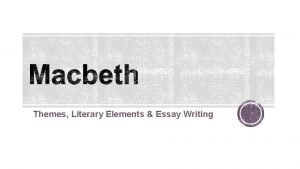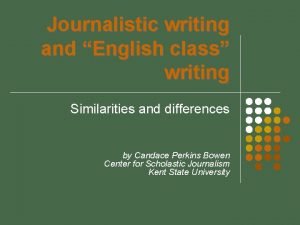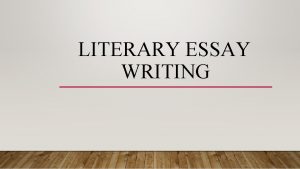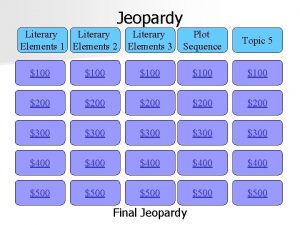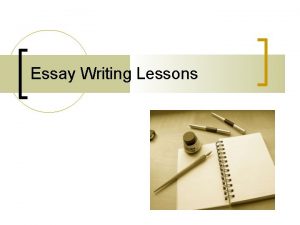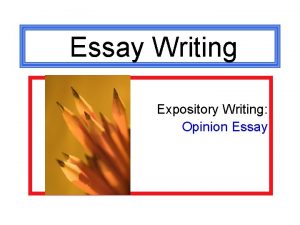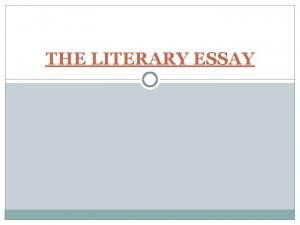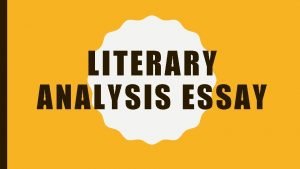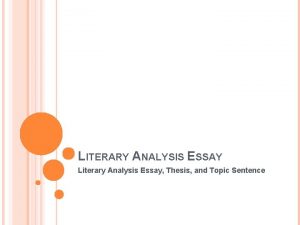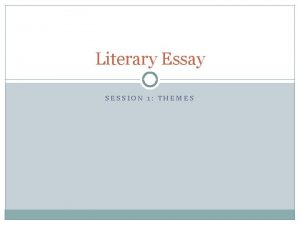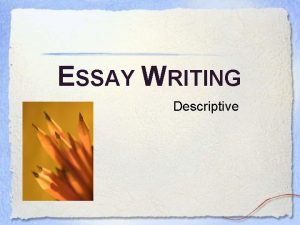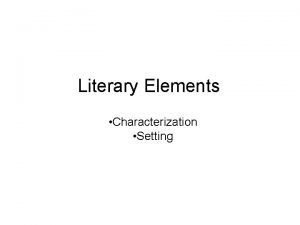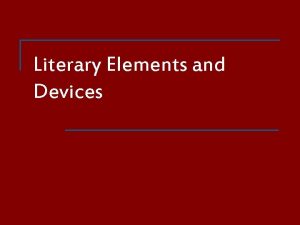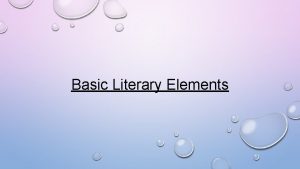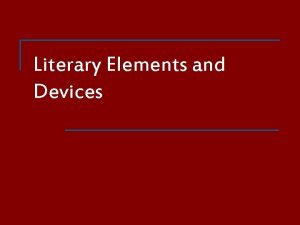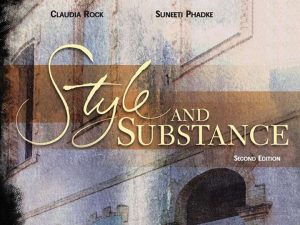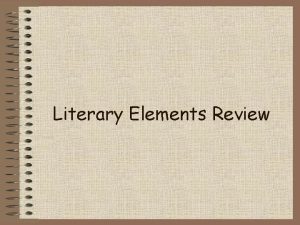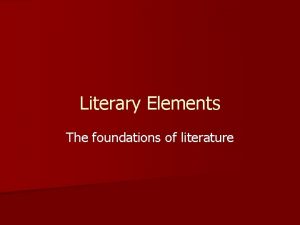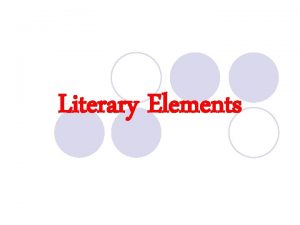Themes Literary Elements Essay Writing Themes are the













































- Slides: 45

Themes, Literary Elements & Essay Writing

§ Themes are the main ideas of the play. § A theme can be defined as “the living idea” which emerges from the plot. § In a very complex play such as Macbeth there can be many themes, some obviously more important that others.

§ Macbeth (the play) questions whether or not fate (destiny) or human nature (choice) determines a man’s future. § Shakespeare allows us to question what it is that causes a seemingly decent man (Macbeth) to commit evil acts. § On the one hand the play is set in motion by the weird sisters’ prophesy that Macbeth will be king, which turns out to be true. § It also often seems that outside forces control Macbeth’s actions. § The play goes out of its way to dramatize how Macbeth deliberates before taking action, which suggests that he alone controls the outcome of his own future. § Others have suggest that Macbeth’s fate may be set in stone but his choices determine the specific circumstances by which he arrives at or fulfils his destiny.

§ Macbeth is often read as a cautionary tale about the kind of destruction ambition can cause. § Macbeth is a man that at first seems content to defend his King and country against treason and rebellion and yet, his desire for power plays a major role in the wat he commits the most dreadful acts (with the help of his ambitious wife of course). § Once Macbeth has had a taste of power, he seems unable and unwilling to stop killing (men, women, and children alike) in order to secure his position on the throne. § Selfishly, Macbeth puts his own desires before the good of his country until he is reduced to a mere shell of a human being.

§ Macbeth is interested in exploring the qualities that distinguish a good ruler from a tyrant (what Macbeth clearly becomes by the play’s end). § It also dramatizes the unnaturalness of regicide (killing a king) although still portraying the killing of King Macbeth. § Although the play is set in 11 th century Scotland (a time when kings were frequently murdered), Macbeth has a great deal of contemporary relevance. § In 1603, King James VI of Scotland was crowned King James I of England, becoming England’s first Stuart monarch. § The play alludes to an unsuccessful Catholic plot (the Gunpowder Plot of 1605) to blow up Parliament and King James. § Shakespeare also pays homage to the Stuart political myth by portraying Banquo as King James’ noble ancestor

§ In Macbeth, appearances, like people, are frequently deceptive. What’s more, many of the play’s most resonant images are ones that may not actually exist. § Macbeth’s bloody “dagger of the mind, ” the questionable appearance of Banquo’s ghost, and the blood that cannot be washed from Lady Macbeth’s hands all blur the boundaries between what is real and what is imagined. § This theme is closely related to the Supernatural.

§ Macbeth is a play where the traditional gender roles are switched. § Lady Macbeth is the dominant partner (at the play’s beginning) in her marriage and she § § § frequently pesters her husband for failing to act like a “man” when he questions killing the king. Lady Macbeth isn’t the only emasculating figure in this play – the weird sisters cast a spell to literally “drain” a man as “dry as hay” and set out to ruin Macbeth. It’s important to note that traditional gender roles are ultimately re-established by the end of the play when Lady Macbeth is excluded from all the decision making and goes mad before she commits suicide. The play also portrays femininity as having kindness and compassion while it associates masculinity with cruelty and violence. Overall, Lady Macbeth and the witches are portrayed as being unnaturally masculine. Macduff argues that the capacity to feel human emotion (love, grief, loss, etc. ) is in fact what makes one a man.

§ Witchcraft features prominently in Macbeth – the witches are the figures that set the lay in motion when they accurately predict that Macbeth will be crowned King. § Although they have supernatural powers their power over Macbeth is debatable. § At times, the weird sisters seem to represent general anxieties about the unknown. § They also represent fears of powerful women who invert traditional gender roles. § Ultimately, the weird sisters are ambiguous figures that raise more questions that can be answered.

§ Violence in Macbeth is central to action. § The play begins with a battle against rebel forces in which Macbeth distinguishes himself as a valiant and loyal warrior. § Later, Macbeth’s murder of King Duncan is condemned as an unnatural deed but they play also raises the question of whether or not there’s any real difference between killing a man in combat and murdering for self-gain. § Violence in all forms is frequently associated with masculinity – the play is full of characters (Macbeth, Macduff, Young Siward, etc. ) that must prove their ‘manhood” by killing. § Even Lady Macbeth asks to be “unsexed” so that she may be “filled with direst cruelty”. § At the same time, the play also suggest that unchecked violence may lead to a kind of emotional numbness that renders one inhuman.

§ Macbeth seems obsessed with the concept of time, although it is not always clear. § When Macbeth murders King Duncan and takes the throne, there are several allusions to the idea that time literally comes to a halt. § Macduff’s final remark that the “time is free” (now that Macbeth is defeated and Malcolm is set to take his rightful position as hereditary monarch) suggests a relationship between the seeming disruption in linear time and the disruption of lineal succession. § The idea is that the country has no future without a rightful and competent ruler at the helm.

One common way of understanding Macbeth is to see the play as representing the journey of the tragic hero. This pattern or genre illustrates the downfall of the central character. It is typical of Shakespeare’s tragedies. The main protagonist must possess certain characteristics to fit the label of a tragic hero. § A man of high estate – our first impression of his greatness is usually through the eyes of others. § Early in the play the audience becomes aware of a driving force within the hero that soon becomes obsessive. This obsession produces inner turmoil. § The obsession is the hero’s tragic flaw, soon becoming a highly destructive force. § The tragic hero is marked by a sense of waste. Ultimately, the audience feels some sympathy for him.

A different way to read the play is to consider Banquo and Macbeth as parallel characters. This involves comparing the actions and behaviour of the two in order to judge their characters. § Both are successful soldiers beloved by King Duncan. § The witches predict good fortunes for both Macbeth and Banquo. Why didn’t Banquo seek power by challenging fate, as Macbeth did? § Duty – Self-interest § Reason – Emotion § Caution – Impulsiveness § Wisdom – Lack of judgement How can Banquo be considered a heroic figure?










A symbol is an object, creature, person, action or situation which is part of a larger unit. The larger unit is often abstract and inexpressible, and thus requires something more concrete to give at expression. § Dagger § Blood § Clothes § Weather/Natural world § Prophecies § Violence In Macbeth, Macbeth’s castle becomes a symbol of hell when the murder of Duncan takes place. The witches are symbols of evil. The growing tree and Birnam Wood are symbols of good, of healthy growth. A writer often employs symbolism, and uses symbolic images.

Shakespeare gives us insight into Macbeth’s mind through a series of key soliloquies. A soliloquy is a speech made by a character on stage. It reveals the character’s thoughts, feelings, intentions and decisions concerning significant turning points in the action of the play. The soliloquy is heard and watched by the audience only – other characters on stage do not hear or witness it. § Act 1, Scene 7, Lines 1 -28 § Act 3, Scene 1, Lines 48 -71 § Act 3, Scene 4, Lines 129 -139 § Act 4, Scene 1, Lines 142 -156 § Act 5, Scene 5, Lines 18 -28

§ Storyboard – Is this a dagger? § Macbeth’s “Is this a dagger” soliloquy is famous for the imagery it evokes, and the uncertainty of this imagery: is Macbeth really seeing a dagger, just as he has seen witches? Is he hallucinating? Should the audience see what he is seeing, or should we have to imagine it?

Imagery refers to words that appeal to the five senses: hearing, taste, touch, sight, and sound. Such word pictures can suggest a mood or idea, and they add emotion and power to the writing. In Act 1, Scene iii, Macbeth says ‘why do you dress me/in borrow’d robes? This is the first of many images of borrowed or ill-fitting clothing in Macbeth. They contribute to the ideas that Macbeth is not the natural king of Scotland, and he feels insecure in this role.

§ Irony occurs when a character is aware or unaware that there is a hidden meaning behind what is said. There is usually a contrast between what is said and the underlying meaning. § For example, when Duncan’s visit is announced, Lady Macbeth says “He that’s coming must be provided for” § She can be understood on two levels: she is referring to her duties as a hostess, but she is also saving that arrangements must be made to murder Duncan. The contrast between the two meanings is clear.

A simile is a way of comparing two unlike things using like or as. In the play, Lady Macbeth says ‘the sleeping and the dead/are but as pictures’. If the sleeping and the dead are like paintings, still and not alive, Macbeth need not fear murdering the sleeping Duncan.

This is a statement that has two different meanings, one of which may be sexual. In Act I, Scene V, Lady Macbeth asks the spirits to “unsex” her. This can mean both “turn her into a man” and “free her of mercy and gentleness, ” qualities associated with women.

§ An allusion is a reference to a historical or literary figure, happening, or event that is meant to enhance the meaning of the story. In Act II, Scene II, Macbeth refers to Neptune, the Roman god of the sea, when expressing fear that his murderous conscience will never be cleansed. § “Will all great Neptune’s ocean wash this blood/clean from my hand? ”

§ The mood is the overall feeling or atmosphere an author creates with his or her selection of details. Macbeth opens on a barren hill with three witches muttering incantations over the background sounds of thunder and lightning. The mood is dark and threatening.

§ Refers to hints about what might happen at a later point in the plot. In Act III, Scene ii, Macbeth says to his wife, “We have scorch’d the snake, not kill’d it. ” In other words, they have not put trouble to rest by killing Duncan.

§ Step 1: Analyse the question § Step 2: Develop a plan § Step 3: Write the response § Step 4: Edit and rewrite

§ Break the question down into parts to decide what it is really asking you. § What are the key terms in the topic? § Is there something in the topic that’s not always true? § Is there a quote from the text? § Are their adjectives or adverbs? (limited, strong, essential etc) § Are there two or three parts to a topic? § Re-assess the topic – what do I now think the topic is really saying? § Paraphrase the topic – rewrite it in your own words.

§ What is your short answer to the question? Keep it simple. § Write down your central argument. § What are your main reasons? § Find an example or two for each reason. Write down some relevant quotes. § List the reasons in a logical order – least to most important from start to end of text. Group similar reasons together, eg characters with similar qualities. Now you have a plan!


Sets up your approach for the whole response and lets your reader or audience know what lies ahead. It should include: § Your main argument – a clear, concise response to the question. § Key terms from the topic, as well as any key concepts you introduce as part of your argument. § Signposts for what will be taken up in the body paragraphs – the main points that you will be discussing in your paragraph.

‘Year of Wonders is a story about survival’ Geraldine Brooks novel, Year of Wonders, is an extraordinary story about surviving the 1666 plague year, when a small Derbyshire village is quarantined and the villagers are forced to confront a scourge beyond remedy or understanding. Whilst the novel is based on surviving the plague and the ramifications of the plague, Brooks also looks at the different aspects that contribute to survival and ultimately what the novel is about, that is, friendship, love, sacrifice and faith. Through these aspects, Brooks is able to depict the human condition and the testing of individuals and society that ultimately influences whether the villagers survive the year, 1666.

Body paragraphs develop and support the central argument. They need to: § Clearly respond to the question § Use evidence from the text § Explain how this evidence supports the central argument and answers the questions. § How does Shakespeare construct meaning? (Symbolism, imagery, etc). § Why does Shakespeare do this? § Ensure that quotes are not too long and FLOW well in the sentence. § Use appropriate metalanguage to construct a supported analysis of a text – play, not novel; audience, not readers etc.

TEEL Structure § Topic sentence – main point for the paragraph. § Evidence – support the point with well-chosen evidence from the text you are discussing. § Explanation – explain the significance of the evidence and how it supports the point. § Links – link back to the topic and link ‘forward’ to lead into the next body paragraph.

Why would Shakespeare do this? Why would Shakespeare write that? Why does Shakespeare want the audience to see this? Why doesn’t Shakespeare want the audience to see that? ALWAYS ask WHY!

Anna uses poppies to numb her pain whilst the community responds with violence and Mem and Anys Gowdie are targeted in the murderous attack. Brooks is showing that the marginalised groups in society are the first to be accused in the face of crisis. The villager’s then turn to superstition as a means of survival, ‘the witch told us we should boil the babe’s hair in his piss and that this would keep off the Plague’, posing a challenge to the moral authority of Michael Mompellion. Brooks is showing the desperate measures that a community would take, from seeking scapegoats to practicing sorcery to increase their chance of survival.

§ The conclusion draws your discussion to a close and should always be included to ensure you submit a completed piece of writing. § The conclusion should: § Clearly refer to the topic and provide a concise response to it. § Restate your central argument, but avoid repeating the same words as the main contention in the introduction. § Include one or two strong, general statements about the text’s significance rather than simply summarizing the examples.

§ Gathering ideas: https: //ed. ted. com/on/LMIdj. Gi. D § The Introduction: https: //ed. ted. com/on/1 e 8 Xop. JN § Body Paragraphs https: //ed. ted. com/on/x. Jnm 8 c. DB § The Conclusion https: //ed. ted. com/on/fb. Gn. Pvla

1. Characters/Themes 2. Structural Elements 3. Quotes 4. Begin writing your practice essay!

 Antigentest åre
Antigentest åre Poetic device
Poetic device Literary elements essay
Literary elements essay Journalistic writing
Journalistic writing Hình ảnh bộ gõ cơ thể búng tay
Hình ảnh bộ gõ cơ thể búng tay Lp html
Lp html Bổ thể
Bổ thể Tỉ lệ cơ thể trẻ em
Tỉ lệ cơ thể trẻ em Gấu đi như thế nào
Gấu đi như thế nào Chụp phim tư thế worms-breton
Chụp phim tư thế worms-breton Chúa yêu trần thế alleluia
Chúa yêu trần thế alleluia Các môn thể thao bắt đầu bằng tiếng nhảy
Các môn thể thao bắt đầu bằng tiếng nhảy Thế nào là hệ số cao nhất
Thế nào là hệ số cao nhất Các châu lục và đại dương trên thế giới
Các châu lục và đại dương trên thế giới Công của trọng lực
Công của trọng lực Trời xanh đây là của chúng ta thể thơ
Trời xanh đây là của chúng ta thể thơ Mật thư anh em như thể tay chân
Mật thư anh em như thể tay chân 101012 bằng
101012 bằng Phản ứng thế ankan
Phản ứng thế ankan Các châu lục và đại dương trên thế giới
Các châu lục và đại dương trên thế giới Thể thơ truyền thống
Thể thơ truyền thống Quá trình desamine hóa có thể tạo ra
Quá trình desamine hóa có thể tạo ra Một số thể thơ truyền thống
Một số thể thơ truyền thống Cái miệng bé xinh thế chỉ nói điều hay thôi
Cái miệng bé xinh thế chỉ nói điều hay thôi Vẽ hình chiếu vuông góc của vật thể sau
Vẽ hình chiếu vuông góc của vật thể sau Thế nào là sự mỏi cơ
Thế nào là sự mỏi cơ đặc điểm cơ thể của người tối cổ
đặc điểm cơ thể của người tối cổ Thứ tự các dấu thăng giáng ở hóa biểu
Thứ tự các dấu thăng giáng ở hóa biểu Vẽ hình chiếu đứng bằng cạnh của vật thể
Vẽ hình chiếu đứng bằng cạnh của vật thể Tia chieu sa te
Tia chieu sa te Thẻ vin
Thẻ vin đại từ thay thế
đại từ thay thế điện thế nghỉ
điện thế nghỉ Tư thế ngồi viết
Tư thế ngồi viết Diễn thế sinh thái là
Diễn thế sinh thái là Dot
Dot So nguyen to
So nguyen to Tư thế ngồi viết
Tư thế ngồi viết Lời thề hippocrates
Lời thề hippocrates Thiếu nhi thế giới liên hoan
Thiếu nhi thế giới liên hoan ưu thế lai là gì
ưu thế lai là gì Khi nào hổ con có thể sống độc lập
Khi nào hổ con có thể sống độc lập Sự nuôi và dạy con của hổ
Sự nuôi và dạy con của hổ Hệ hô hấp
Hệ hô hấp Từ ngữ thể hiện lòng nhân hậu
Từ ngữ thể hiện lòng nhân hậu Thế nào là mạng điện lắp đặt kiểu nổi
Thế nào là mạng điện lắp đặt kiểu nổi


